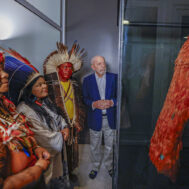“We’ve all deduced that this isn’t just about a dome,” he says. “They want to Han-ify all Muslims, to remove Islam from life . . . To stop prayer, stop religious study. To change our culture, our way of living.” “Ding,” a Muslim man describing the destruction of the dome of the Najiaying Mosque in Yunnan Province in June 2023. The removal of the essential Islamic features of the mosque sparked a protest by thousands of men, women and children from the surrounding community. Hundreds of armed police quashed the protests, the government demanded that all ‘instigators’ turn themselves in, and neighbors report on anyone involved.

Wlodek Cieciura, Elderly Hui man, July 2006, CC-BY-SA-2.5.
The People’s Republic of China’s suppression of Muslim religious practice has now expanded from Xinjiang province to other areas of China. The PRC’s Ningxia and Gansu Provinces are home to large ethnic populations of Hui Muslims. Government policies to eradicate religion can be seem most publicly in the destruction and of mosques, cemeteries, and sacred sites, and the removal of all Islamic architectural features in the remaining mosques and their replacement with “Chinese” architectural forms – or with the bulldozing of the mosque or shrine and turning the religious edifice into a barren lot.
U.S. Has Renewed a Cultural Heritage Agreement with China, Despite Brutal Repression of Muslim, Buddhist and Christian Religion in China
In 2023, the Chinese government requested renewal of its January 14, 2019 Memorandum of Understanding (MOU) on cultural heritage with the United States.[i] On January 10, 2024, the U.S. government announced its renewal. This agreement, which dates back to 2013, must be renewed every five years and among other criteria, the applicant must show that it is working diligently to preserve cultural heritage. This request for extension does not meet the legal requirements of the U.S. Cultural Property Implementation Act (CPIA) and should have been terminated.

Hui family celebrating the religious holiday, Eid. Now banned in much of Muslim China. 12 October 2010, Author Cecikierk, public domain.
Renewal turns a blind eye to China’s deliberate destruction of thousands of cultural sites forming the heritage of its minority peoples. It undercuts U.S. efforts to prevent the entry to the U.S. of goods made by slave labor by Uyghur camp inmates and former detainees who are confined in locked factories throughout China.
Crucially, renewal implicitly recognizes the Chinese government’s right to define, control, and even destroy art and cultural heritage throughout its territory – including Tibet, Xinjiang, Mongolia, Hong Kong – and now in Muslim communities across China.
China’s Cultural Genocide
For the last decade, China’s President Xi Jinping has aggressively pursued a policy to replace all minority people’s cultural life, especially religious expressions including Tibetan Buddhism, Islam and Christianity, with a singular devotion to the Chinese Communist Party. In Xi’s worldview, Han culture is indivisible from Chinese nationalism and vice versa. Both are threatened by religious, linguistic and cultural diversity. The Chinese Communist Party is equated with ‘Han’ Chinese culture and language – and the Party’s entirely secular world view provides all the spiritual guidance necessary to China’s citizens.
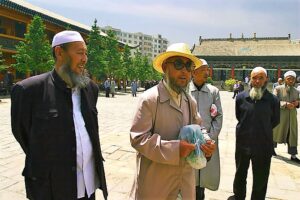
After prayers at Dongguan mosque, Xining, Qinghai, China, 31 May 2007, Author B_cool from Singapore, CCA 2.0 Generic license.
Religious activities have been seen as anti-social for a long time in China, but under President Xi, who explicitly called for the Sinicization of all religion in 2015, they are no longer even tolerated. Increasingly, conformity with Communist Party goals and belief is directly linked to Xi himself as the Party’s deeply venerated, irreplaceable leader, the embodiment of its highest qualities. To put it plainly, Xi is the new Mao Zedong – he epitomizes the new China. To disagree or have any other allegiance is treasonous. Religious belief and ethnic identity are seen as forming inherently divergent loyalties and inciting criminal deviation.
China’s government has rapidly accelerated its repression of religion and culture. Chinese citizens with religious ties are regularly denied access to social services including transportation and fired from government jobs even if they are Party members. The repression affects people of Christian and Buddhist faith as well as Muslims. It can be seen in the continuing destruction and removal of crosses from Christian churches. It is behind China’s policy of forcing of Tibetan children into locked boarding schools where speaking Tibetan is forbidden. Directives have been issued requiring that Tibetan monks and nuns express daily allegiance to communism, condemn the Dalai Lama and publicly denigrate their own traditional beliefs.
Government Destruction of Places of Worship

Posters in Ximen Mosque in Dali. Islamic related posters were replaced by government posters. From left to right: Core Socialist Values, idioms of promoting the harmony of Dali, slogan of protecting the minor, “four awareness” and slogans of promoting social development. 9 July 2023, Author User3204, CCA-SA 4.0 International license.
In 2014, there were more than 4,000 mosques in each of Ningxia and Gansu Provinces, based upon satellite imagery and digital analyses of sampled villages. The number of mosques is now reduced by at least a third, and satellite analysis shows that 90% of the mosques in Ningxia and 80% in Gansu have been altered to remove Islamic architectural forms such as domes and minarets. Now, even in parts of China where Muslims are a small minority, from Beijing City to Yunnan Province, mosque buildings are decorated with pagoda-like tops and Communist slogans hang beside Koranic texts – or have replaced them entirely.
A Muslim man in Ningxia explained how the services at his local village mosques had changed:
“Now, whenever a prayer starts, it’s not the words of Allah in the Koran, it’s a long speech by the imam on how the Communist Party of China is the single legitimate source of power…”
He described his visit to the famous Weizhou Grand Mosque:
“It’s an empty building now, there are locks all over it… “It’s like the Communist party saying ‘fuck you’ to all Muslims . . . This is the most famous mosque in the whole region, and they can shut it down just like that?”
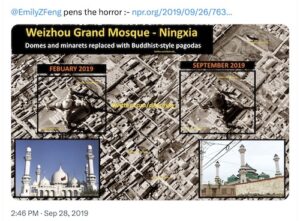
Weizhou Grand Mosque Transformation, dome and minarets removed, Emily Z. Feng on NPR, via Facebook.
China’s “mosque consolidation policy” forbids the construction of any new religious venues and urges local authorities to “compress” the number of mosques by closing them down and destroying or repurposing them as factories, libraries, or community centers, thus reducing access to religious sites. People who visit mosques more than a few times a year can lose their jobs or be denied their pensions. The ban on children learning their religion, the threats to employment and retirement combine with a general fear of being compromised in the governments eyes. Fewer and fewer people dare to be seen publicly practicing religion. The government then uses the reduced number of attendees to justify ‘consolidating’ mosques by reducing their number.
The government’s typical process in closing a mosque has been first to remove all architectural elements and signage that signify Islam, for example, domes and minarets, then to remove the large halls used for prayer to render the mosque unusable. Or, the government will demolish the ablution rooms for washing before prayer and can then take over and repurpose a building as a factory or administrative center.
Surveillance, Intimidation, Incarceration and Children Taken from Families

Chinese state propaganda photo of an “orphanage” for children confiscated from Uyghur concentration camp detainees, with no access to family, language or culture. (From Chinese social media).
The destruction of mosques is only the most visible sign of religious repression. China’s government is working to eliminate religion by instilling fear in its entire Muslim population in Ningxia and Gansu Provinces, just as it did in Xinjiang. Surveillance systems are installed at the entrances and in the prayer halls of the remaining mosques; everyone is watched, but a key component of the government’s Sinicization policy is to make it illegal for people under eighteen to enter mosques. Neighborhoods have watch committees to report if someone refuses to eat pork or drink alcohol- or worse – is teaching their children religion at home. People know that anyone who visits a mosque or is reported as praying at home is suspect as a social deviant. They have seen what has happened to Muslims in Xinjiang and are afraid they are next.
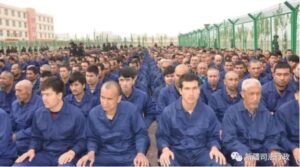
Detainees in Xinjiang’s concentration camps, where torture and brainwashing are the daily regimen. Photo from Chinese social media; taken down after circulating outside China)
Xinjiang has suffered the worst repression, through the taking of a million adults of all ages who have committed no crime, from teens to elderly grandparents, out of rural and urban communities and locking them in horrific prison camps where brainwashing is called ‘education’ and torture is an everyday occurrence. Such prisoners often also lose their children, as grandparents and other relatives are not allowed to take over their care. Over 800,000 children in Xinjiang as young as toddlers have been removed into ‘care centers’ where they cannot contact their families or speak their own language. Young people, especially women, are taken to forced labor factories all over China. If they refuse, their families are threatened with imprisonment in the camps.
Cultural Erasure in Xinjiang – Other Minorities Fear They Are Next

ASPA’s Xinjiang Data Project, estimated Mosques damaged and destroyed, January 10, 2020. Courtesy Australian Strategic Policy Institute.

Screenshot from CNN video ‘Pure evil’: Satellite images show destroyed Uyghur cemeteries in China,” report by CNN’s Matt Rivers.
The Australian Strategic Policy Institute (ASPI) reported that by 2020, in Xinjiang Province, the largest concentration of Muslims in China, 65% of the mosques had been damaged or destroyed. ASPI described the Chinese government’s goal:
“The deliberate erasure of tangible elements of indigenous Uyghur and Islamic culture in Xinjiang appears to be a centrally driven yet locally implemented policy, the ultimate aim of which is the ‘sinicisation’ (中国化) of indigenous cultures, and ultimately, the complete ‘transformation’ (转化) of the Uyghur community’s thoughts and behaviour.”
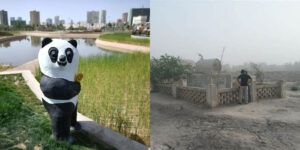
Tomb of Lutpulla Mutellip, razed and transformed into a Happiness Park in Xinjiang.
An April 19, 2018, document leaked to the Uyghur Tribunal, Notice of the General Office of the Central Committee of the Communist Party of China and the General Office of the State Council on Printing and Distributing “Suggestions on Strengthening and Improving Islamic Work in the New Situation.” This document sets forth a number of strategies for ‘Sinicizing’ Islamic religion, of which mosque consolidation is just one element of a far larger program to “strengthen the standardized management of the construction, renovation and expansion of Islamic religious venues.” Other leaked documents have made clear that destruction of buildings for worship is just the first step in far broader programs of surveillance, intimidation, indoctrination, and punishment.
Most recently, The Chinese government has announced that as of February 1, 2024, Xinjiang will have its own, more restrictive “Regulations on religious affairs,” for which an English translation is available at the Bitter Winter human rights organization website. These new regulations, specific to Xinjiang, effectively criminalize both religious activity and many forms of traditional customs and culture. They require that religious schools and teachers “interpret the teachings and canons in line with the development and progress requirements of contemporary China and the excellent traditional Chinese culture.” The new rules state that religion should not “interfere with” “clothing, weddings, funerals and other ethnic customs,” that “religious activity sites that are newly built or renovated, expanded or rebuilt should reflect Chinese characteristics and style in terms of architecture, sculptures, paintings, decorations, etc.”
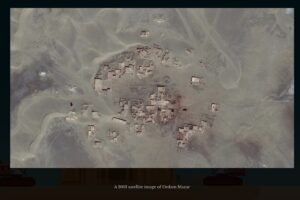
2013 satellite image of ancient shrine Ordam Mazar, Nathan Ruser , Dr James Leibold , Kelsey Munro & Tilla Hoja, Cultural erasure, ASPI, 24 September 2020.
In Xinjiang, the government has already demolished 30% of important sacred shrines, cemeteries and pilgrimage sites and damaged another 27.8%. Some of these ancient sacred sites had been listed as ‘protected’ under Chinese heritage laws. By 2020, 17.4% of ‘protected’ sites had been destroyed and 61.8% of unprotected sites had been damaged or destroyed. Altogether, the Australian Strategic Policy Institute estimates that between 2017 and 2023, approximately 16,000 mosques – an estimated 65% of mosques in Xinjiang – were damaged or destroyed, leaving many communities without any places for worship at all. Most demolished sites have been bulldozed and left as empty lots.
Only in the popular tourist cities of Urumqi and Kashgar, have most mosques had been left intact, although worship is prohibited in many. They exist for the benefit of tourists and in order to make the government’s denial of its policy of destruction believable.
China’s Cultural Agreement with the U.S. is an Outrage

Complete destruction of Ordam Mazar, Cultural erasure, ASPI, 24 September 2020.
During the 2018-2023 5-year MOU with China, U.S. and European governmental bodies and NGOs repeatedly stated that China’s government policies against its Muslim minorities constituted genocide.[ii] During this limited time frame, in Xinjiang province alone, the PRC has imprisoned a million innocent people, subjected tens of thousands to torture, forced sterilization,[iii] and forced labor, and taken nearly a million infants and children away from parents and relatives into state-run orphanages, where they are given new names, indoctrinated in Chinese Communist Party doctrine and taught to speak exclusively Han Chinese language.[iv]
Religious leaders and teachers, even the very elderly, have been disappeared into the camps and many are known to have died there after severe punishment. Just before China’s latest request for renewal of the China MOU, the State Department designated China as a “Country of Particular Concern” under the International Religious Freedom Act (IRFA) along with Burma, Iran, and North Korea, for having “engaged in or tolerated systematic, ongoing and egregious violations of religious freedom.” This is the most severe designation under the IRFA.

World famous Uyghur anthropologist Rahile Dawut, working in Xinjiang in 2005, “disappeared” in 2017, whereabouts unknown, Photo credit Lisa Ross.
A 2021 study by the Uyghur Human Rights Project details how over 300 noted intellectuals and cultural producers have all disappeared into the camps and prisons.[v] The State Department’s Office of International Religious Freedom reported in May 2021 that the whereabouts of “hundreds of prominent Uyghur intellectuals, religious scholars, cultural figures, doctors, journalists, artists, academics, and other professionals… remained unknown.”[vi] Editors of previously approved textbooks on Uyghur history have been given life sentences and “suspended” death sentences for “inciting ethnic hatred” and “fabricating separatist materials.”[vii]
The same report quotes Xi Jinping, stating that the government’s actions to Sinicize Islam were “totally correct and must carry on for a long time.”[viii] Analysts believe this “cultural cleansing” is intended to deprive the Uyghur population of potential future leadership and to remove the custodians of cultural heritage from communities.
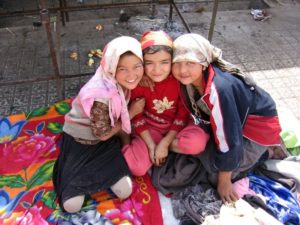
Uyghur girls at a Khotan Market, October 2005, Author Colegota, CCA-SA 2.5 Spain license.
China is not “protecting” the cultural heritage of millions of its citizens. It is destroying it. China is not preserving history, it is rewriting it to falsely portray once autonomous countries within its current borders as ‘forever Chinese.’ The People’s Republic of China is in violation of the International Religious Freedom Act of 1998 (IRFA) as well as the UN Charter and UNESCO Convention.
Renewing the MOU at this time effectively signals approval for China’s imposition of a single cultural norm and its government’s vicious persecution of religious and cultural minorities. Further, it provides diplomatic cover for the PRC’s denial of its State-sponsored genocide and cultural destruction in Xinjiang today. Renewal supports the PRC’s propaganda campaign to hide its crimes from the mass of the Chinese people and the international public. It gives the PRC another tool to utilize in the deliberate erasure of the cultures, religions, and languages of China’s minority peoples. However diplomatically convenient this agreement is for the Department of State, it is contrary to everything that the United States stands for – or should stand for today.
Additional Reading:
Human Rights Watch, China: Mosques Shuttered, Razed, Altered in Muslim Areas, Curbing Islam via ‘Consolidation’ Policy in Ningxia, Gansu Provinces, November 22, 2023, https://www.hrw.org/news/2023/11/22/china-mosques-shuttered-razed-altered-muslim-areas
Nathan Ruser, James Leibold, Kelsey Munro & Tilla Hoja, Cultural erasure, Tracing the destruction of Uyghur and Islamic spaces in Xinjiang, Australian Strategic Policy Institute (ASPI), 24 September 2020. https://www.aspi.org.au/report/cultural-erasure
SPECIAL REPORT: 2023 CHINA MOU – Building China’s Art Monopoly and Destroying Minority Culture and Identity, Testimony to the Cultural Property Advisory Committee, Bureau of Educational and Cultural Affairs, U.S. Department of State, Kate Fitz Gibbon for Committee for Cultural Policy and Global Heritage Alliance – May 26, 2023, https://culturalpropertynews.org/special-report-2023-china-mou-building-chinas-art-monopoly-and-destroying-minority-culture-and-identity/
The Xinjiang Data Project, Kelsey Munro et alii, Australian Strategic Policy Institute, 25 September 2020, https://www.aspi.org.au/news/xinjiang-data-project-website-launch
NOTES:
[i] Proposal to extend The Memorandum of Understanding between the Government of the United States of America and the Government of the People’s Republic of China Concerning the Imposition of Import Restrictions on Categories of Archaeological Material From the Paleolithic Period Through the Tang Dynasty and Monumental Sculpture and Wall Art at least 250 Years Old, 88 FR 32264, 05/19/2023, https://www.federalregister.gov/documents/2023/05/19/2023-10769/proposal-to-extend-cultural-property-agreement-between-the-united-states-and-china.
[ii] In 2021, the UK Parliament voted unanimously to declare that China’s government was committing genocide and crimes against humanity in Xinjiang. Inter-Parliamentary Alliance on China. UK Parliament Unanimously Declares the Chinese Government is Committing a Genocide Against Uyghurs in a Historic First, January 2021, https://ipac.global/uk-parliament-unanimously-declares-the-chinese-government-is-committing-a-genocide-against-uyghurs-in-historic-first/
[iii] Id. at 2.
[iv] The United States Holocaust Memorial Museum’s Simon-Skjodt Center for the Prevention of Genocide “seeks to do for victims of genocide today what was not done for the Jews of Europe.” The organization believes that the Holocaust was preventable, and that future genocides can be prevented with bipartisan commitment among policy makers to prevent and respond to genocide and crimes against humanity. To that purpose the Center engages in “extensive research and analysis, education, and public and governmental outreach.” United States Holocaust Memorial Museum (USHMM), “To Make Us Slowly Disappear,” https://www.ushmm.org/genocide-prevention/reports-and-resources/the-chinese-governments-assault-on-the-uyghurs.
[v] Abdullah Qazanchi, contributions by Abduweli Ayup, ‘The Disappearance of Uyghur Intellectual and Cultural Elites: A New Form of Eliticide,’ Uyghur Human Rights Project, December 8, 2021, https://uhrp.org/report/the-disappearance-of-uyghur-intellectual-and-cultural-elites-a-new-form-of-eliticide/
[vi] United States Department of State, Office of International Religious Freedom, 2020 Report on International Religious Freedom: China—Xinjiang, Executive Summary, 85, 2020, https://www.state.gov/wp-content/uploads/2021/05/240282-CHINA-INCLUDES-TIBET-XINJIANG-HONG-KONG-AND-MACAU-2020-INTERNATIONAL-RELIGIOUS-FREEDOM-REPORT.pdf .
[vii] Id. at 15. “Former Deputy Secretary of the Xinjiang Education and Work Committee Sattar Sawut received a two-year suspended death sentence, while Alimjan Memtimin (Deputy Director General of the Xinjiang Education Department), Tahir Nasir (former president of the Education Publishing House), and other editors were given life sentences.”
[viii] Id.
 Before and after: Yangjiazhuang mosque. Courtesy Bitter Winter.
Before and after: Yangjiazhuang mosque. Courtesy Bitter Winter. 
